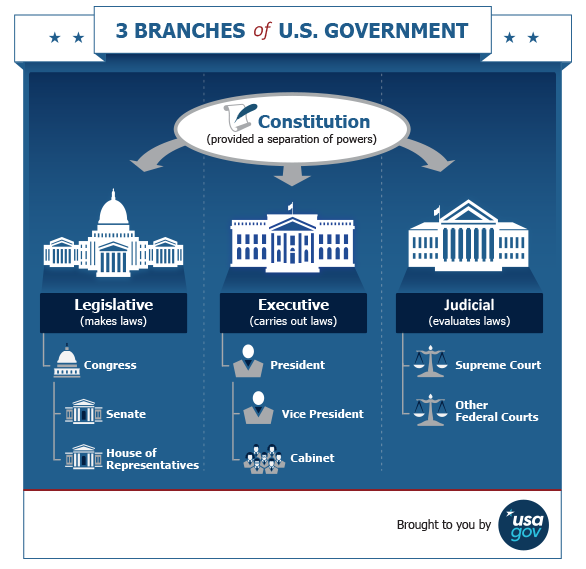PH FACT CHECKER – The Federal Government Of The United States Is Run By Branches #PimpinIsPolitics

How the U.S. Government Is Organized
The Constitution of the United States divides the federal government into three branches to ensure a central government in which no individual or group gains too much control:
- Legislative – Makes laws (Congress)
- Executive – Carries out laws (President, Vice President, Cabinet)
- Judicial – Evaluates laws (Supreme Court and Other Courts)
Each branch of government can change acts of the other branches as follows:
- The president can veto laws passed by Congress.
- Congress confirms or rejects the president’s appointments and can remove the president from office in exceptional circumstances.
- The justices of the Supreme Court, who can overturn unconstitutional laws, are appointed by the president and confirmed by the Senate.
The U.S. federal government seeks to act in the best interests of its citizens through this system of checks and balances.
Legislative Branch
The legislative branch enacts legislation, confirms or rejects presidential appointments, and has the authority to declare war.
This branch includes Congress (the Senate and House of Representatives) and several agencies that provide support services to Congress. American citizens have the right to vote for senators and representatives through free, confidential ballots.
- Senate – There are two elected senators per state, totaling 100 senators. A senate term is six years and there’s no limit to the number of terms an individual can serve.
- House of Representatives – There are 435 elected representatives, which are divided among the 50 states in proportion to their total population. There are additional non-voting delegates who represent the District of Columbia and the territories. A representative serves a two-year term, and there’s no limit to the number of terms an individual can serve.
Executive Branch
The executive branch carries out and enforces laws. It includes the president, vice president, the Cabinet, executive departments, independent agencies, and other boards, commissions, and committees.
American citizens have the right to vote for the president and vice president through free, confidential ballots.
Key roles of the executive branch include:
- President – The president leads the country. He/she is the head of state, leader of the federal government, and commander-in-chief of the United States Armed Forces. The president serves a four-year term and can be elected no more than two times.
- Vice President – The vice president supports the president. If the president is unable to serve, the vice president becomes president. He/she can serve an unlimited number of four-year terms.
- The Cabinet – Cabinet members serve as advisors to the president. They include the vice president and the heads of executive departments. Cabinet members are nominated by the president and must be approved by the Senate (with at least 51 votes).
Judicial Branch
The judicial branch interprets the meaning of laws, applies laws to individual cases, and decides if laws violate the Constitution.
The judicial branch is comprised of the Supreme Court and other federal courts.
- Supreme Court – The Supreme Court is the highest court in the United States. The justices of the Supreme Court are nominated by the president and must be approved by the Senate (with at least 51 votes). Congress decides the number of justices. Currently, there are nine. There is no fixed term for justices. They serve until their death, retirement, or removal in exceptional circumstances.
- Other Federal Courts – The Constitution grants Congress the authority to establish other federal courts.
Source (Read More) https://www.usa.gov/branches-of-government
And it is written, just like the U.S. Constitution…
True Democracy Is The Ladies Choice.
Rylan Branch
Janitor/Maintenance Man
PimpHop.com Life Experience Magazine
Established in 2002
Keeping it “P” till 3003




